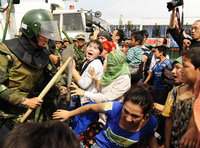For those in the West eager to uncover another Tiananmen-like crackdown by Chinese authorities last week in the Xinjiang provincial capital of Urumqi, the true story disappoints, even as it points to a potentially far-more-destabilizing social phenomenon: the emergence of race riots inside allegedly homogenous China. Note that President Hu Jintao's embarrassingly rushed departure from the G-8 meeting in Italy was not provoked by Sunday's riots by angry Uighurs, but rather by Tuesday's even uglier revenge riots by even angrier -- and better-armed -- Han Chinese.
The makings of this unrest should strike us Americans as painfully familiar. The influx of settlers from the East left the poorer, less-educated indigenous people feeling crowded out and discriminated against in their homeland. The suddenly tougher economic times exacerbated the resulting ethnic tension, despite government efforts to paper over the social anger with enlightened affirmative action-style programs. Finally, the implied sexual threat to the dominant majority served as the match for the outbreak of vigilante "justice."
If the narrative sounds like a mélange of plots from American "old West" and civil rights-era movies, that's because many of the same dynamics are in play -- with Xinjiang substituting for the role of Texas or California: too valuable in natural resources for the central government to give up, but often too hard to control in terms of its frontier tensions and mob violence.

